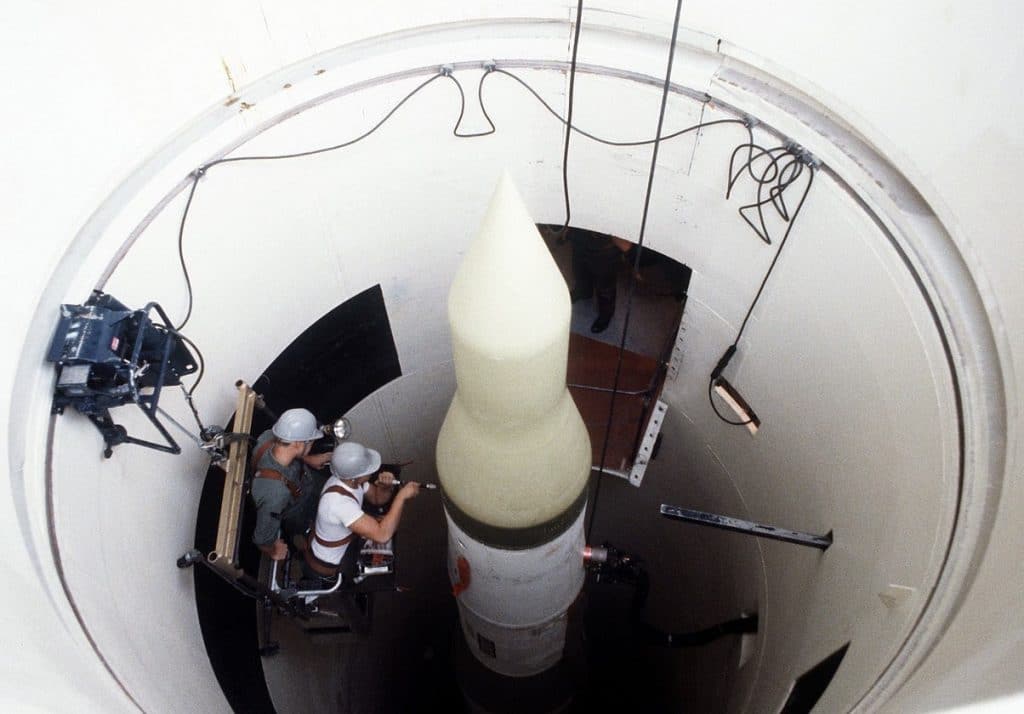Why the new US ICBMs would be too expensive even if they were free
By Robert J. Goldston | January 3, 2020

The proposed US nuclear modernization program includes replacing the 400 existing Minuteman III missiles with a new set of “Ground-Based Strategic Deterrent” missiles and their associated facilities. The cost for this modernization is very large, with an advertised price tag of $85 billion, and if history is any guide, a substantial cost escalation is likely. On the one hand, if these silo-based intercontinental ballistic missiles (ICBMs) deter attacks that would cost tens of millions of lives, then they are worth this much many times over. On the other hand, if they are more likely to cause massive numbers of human deaths, then they are immensely expensive even if they cost nothing.
The primary argument for silo-based ICBMs is that they would “sponge up” a large number of Russian warheads if the United States were attacked. Experts estimate that it would take two Russian warheads to destroy with high confidence one of the 400 active US ICBMs, each armed with a single warhead.
This might seem like a good deal, until you ask what the impact of 800 Russian warheads exploding on US territory would be. Beyond the immediate local death and devastation, the prompt fallout would be intense, spreading primarily eastward from the silos in Colorado, Montana, Nebraska, North Dakota, and Wyoming, potentially killing millions of civilians. The long-term contamination would be about ten times greater than that from the Chernobyl accident, rendering a large swath of the Midwest uninhabitable for generations.
But maybe, the proponents might argue, this is still a good deal for the United States because then Russia would have that many fewer warheads left after striking US soil. Under the New START agreement, the Russians would still have 750 as-yet unused strategic warheads. This is enough to murder many tens of millions of American citizens and render US society unviable. The effect on the global climate would be devastating, resulting in a nuclear winter that could kill a billion people by disrupting agriculture—not just in the United States and Russia, assuming the inevitable counterattack, but across the whole northern hemisphere. Consequently, this so-called ICBM sponge both leaks poison and does not soak up enough warheads to protect Americans, nor the world, in any meaningful way.
A second argument proposed by advocates for silo-based ICBMs is that the United States needs the fast-launch capability that ICBMs provide. But the United States can launch missiles from submarines nearly as quickly as from land-based silos, and these missiles can reach many sites even more rapidly, making them more than adequate, in a war-fighting scenario, for attacking strategic forces in Russia or elsewhere. Indeed, the fact that US ICBMs would need to overfly Russian air space even if their targets were not in Russia greatly limits their utility.
Furthermore, the only really compelling reason that the United States would need a quick nuclear launch in the first place would be if the silos themselves were under attack. That’s because the silo-based missiles constitute the only leg of the nuclear triad that can be easily targeted, and an attack on them would put the United States in a use-them-or-lose-them position. So, eliminate the silos and you eliminate the need for a fast launch-under-attack capability. The United States can hold Russian military and industrial facilities at risk, for the purpose of deterrence, using submarines and stealth bombers armed with air-launched cruise missiles. The Russian facilities are not going anywhere quickly.
A third argument in favor of silo-based ICBMs is that they provide assurance against a technological surprise that renders the US nuclear-armed submarine fleet vulnerable to a first strike. US stealth bombers themselves are vulnerable to a first strike, since they are located at a limited number of airfields and would take hours to get airborne. If US war planners are concerned about the seas turning transparent, they can disperse their strategic bombers to more airfields and place them on “strip alert,” allowing them to become airborne in ten minutes. Then they can be put safely in the air when a Russian attack is detected, before the projected arrival of warheads. The use of strategic bombers offers a key benefit—if the attack proves to be a false alarm, bombers, unlike ICBMs, can be recalled.
There is a political aspect to this problem as well. Citizens of the states of Colorado, Montana, Nebraska, North Dakota, and Wyoming may be concerned about losing military funding, and so jobs, if silo-based ICBMs are eliminated. These states can retain the same amount of military funding, or receive even more, if they were to house upgraded Air Force bomber facilities without the silo-based ICBMs. As a bonus, they would be far less of a target for Russian attack, since only a few warheads, not 800, would be needed to disable their air bases.
Now consider the two main arguments for eliminating silo-based ICBMs. First, they are highly destabilizing. If both sides have such missiles, there is a tremendous potential military advantage in launching first, particularly if there is a concern that the other side might have effective, but limited, strategic missile defenses. For example, the Russians could be concerned that at a time of heightened tension the United States would strike first, not just with silo-based ICBMs, but also with submarine-launched ballistic missiles and perhaps strategic bombers armed with air-launched cruise missiles. Under such reasoning, if the United States is capable of thereby destroying much of Russia’s nuclear forces in a first strike (including Russia’s silo-based ICBMs) and might be able to defend against the rest of Russia’s retaliatory response with anti-ballistic-missile technology, then the worst-case Russian analysis would lead to grave concern that the United States might indeed undertake a first strike in a time of heightened tension.
And if that is a concern, in a time of heightened tension Russia could perceive a need to pre-emptively launch against the US silo-based ICBMs, as it would give Russia at least a chance of reducing the damage to its homeland. It would be logical to a Russian war planner to include an attempt to take out US command and control with a large-scale decapitating strike that could also overwhelm US ballistic missile defenses through sheer numbers of warheads. This is, no doubt, a terrifying scenario.
Consider the alternative scenario, where neither the United States nor Russia has silo-based ICBMs, and their strategic bombers are dispersed at multiple airfields, capable of rapidly becoming airborne. Now neither side has use-them-or-lose-them forces that are much better employed in a first strike than to act as so-called sponges. Furthermore, there is no motivation for either side to start a nuclear war by attacking with hundreds of warheads. It is still a horrifying scenario for each side to have over 1,000 deployed warheads, but it is a far more stable situation, because each side’s warheads are impossible for the other side to destroy in a first strike.
The second argument against silo-based ICBMs is that they will almost surely be configured for launch under attack, making it possible that a false alarm can trigger a full-scale nuclear war. In 1983 the new Soviet early warning satellites indicated a missile attack from the United States. Fortunately, an experienced Soviet officer, Lt. Col. Stanislav Petrov, was in charge that night. He knew about the weaknesses of their new satellites and computers, so he waited for radar confirmation, which never came. There were also numerous occasions where false alarms in the US early warning system nearly led to war. It cannot be overstressed that with modern capabilities for cyberattack, including by malicious third parties, the risk of a false alarm grows with time.
With rising international tensions, the United States should be doing everything possible to minimize the risk of nuclear war. No matter what their cost—even if they were free—US silo-based ICBMs are not worth maintaining or modernizing. They have overwhelmingly negative value and therefore should be eliminated. The United States could, in principle, increase the number of warheads carried by its submarine and bomber forces by the number eliminated from its ICBM force to remain in compliance with an extended New START treaty. A better solution, however, would be to negotiate with Russia, once New START has been extended, to eliminate its own silo-based ICBMs as well. This would ease Russia’s fear of a first strike and so its own perceived need for a launch under attack posture, thereby lowering the risk of nuclear war all around. It would also allow a 25 percent reduction in deployed warheads on both sides, which would be a welcome, if limited, step toward the nuclear disarmament called for in the Nuclear Non-Proliferation Treaty and the Treaty on the Prohibition of Nuclear Weapons.
The author would like to thank Sharon K. Weiner for helpful discussions.
Editor’s note: The original version of this story incorrectly stated that, during the 1983 false alarm incident, Soviet early warning systems indicated a “massive” incoming missile attack. The system actually indicated a total of five incoming missiles. The article has been corrected accordingly.
Together, we make the world safer.
The Bulletin elevates expert voices above the noise. But as an independent nonprofit organization, our operations depend on the support of readers like you. Help us continue to deliver quality journalism that holds leaders accountable. Your support of our work at any level is important. In return, we promise our coverage will be understandable, influential, vigilant, solution-oriented, and fair-minded. Together we can make a difference.
Keywords: Russia, United States, land-based ballistic missiles, launch under attack, nuclear modernization
Topics: Nuclear Weapons, Opinion
















North Korea / Iran / Russia doesn’t need ICBMs to pose a threat to the US. Because of the small size of nuclear devices, they can be preemptively placed in cities by operatives an detonated at a moments notioe. Bypassing any missle shield and faster than any new hypersonic missle. Acknowledging this publicly wouldn’t sell public support for new weapon systems, now would it?
The 1983 false alarm of Soviet early warning system did not indicate a massive launch. It was a total of five. Col Petrov knowing their system had flaws AND the US would not launch just five missiles in a preemptive strike allowed him to go with his instincts and notify command the launch indication was a error from their system.
Good catch. The text was changed and an erratum was added.
This theory has some good points. However…. Silo based ICBMS are a reality that both sides have and that our nuclear enemies are absolutely not going to give up under any circumstances. For us to fail to maintain and upgrade our SBICBMs would be a tragic mistake. It would undermine and overbalance the existing system of nuclear detent and likely result in a growing technical divide between our nuclear readiness and the rest of the nuclear world. The reality is that while we ostensibly have a poor and ineffective nuclear defence program, most of the others have… …NONE AT ALL…… Read more »